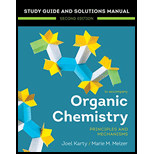
Concept explainers
(a)
Interpretation:
The atom in the given pair that has the higher priority is to be determined.
Concept introduction:
When assigning priorities to substituents, the atom having the greater
Answer to Problem C.1P
F has the higher priority.
Explanation of Solution
The given pair of atoms is: F and O.
The atomic number of fluorine is 9 while that of oxygen is 8.
Thus, fluorine has a greater atomic number than oxygen. Hence, F gets the higher priority in this pair.
Fluorine has a greater atomic number than oxygen, and hence, it gets a higher priority.
(b)
Interpretation:
The atom in the given pair that has the higher priority is to be determined.
Concept introduction:
When assigning priorities to substituents, the atom having the greater atomic number has the higher priority. In case of comparison between isotopes, the one having the greater atomic mass gets the higher priority.
Answer to Problem C.1P
P has the higher priority.
Explanation of Solution
The given pair of atoms is: P and F.
The atomic number of phosphorus is 15 while that of fluorine is 9.
Thus, phosphorus has a greater atomic number than fluorine. Hence, P gets the higher priority in this pair.
Phosphorus has a greater atomic number than fluorine, and hence, it gets a higher priority.
(c)
Interpretation:
The atom in the given pair that has the higher priority is to be determined.
Concept introduction:
When assigning priorities to substituents, the atom having the greater atomic number has the higher priority. In case of comparison between isotopes, the one having the greater atomic mass gets the higher priority.
Answer to Problem C.1P
Explanation of Solution
The given pair of atoms is:
Want to see more full solutions like this?
Chapter C Solutions
EBK ORGANIC CHEMISTRY: PRINCIPLES AND M
- Convert 1.38 eV into wavelength (nm) and wavenumber (cm-1) (c = 2.998 x 108 m/s; h = 6.626 x 10-34 J*s).arrow_forwardCan you help me understand the CBC method on metal bridging by looking at this problem?arrow_forwardA partir de Aluminio y Co(NO3)2ꞏ6H2O, indicar las reacciones a realizar para obtener Azul de Thenard (Al2CoO4).arrow_forward
 Organic Chemistry: A Guided InquiryChemistryISBN:9780618974122Author:Andrei StraumanisPublisher:Cengage Learning
Organic Chemistry: A Guided InquiryChemistryISBN:9780618974122Author:Andrei StraumanisPublisher:Cengage Learning Organic ChemistryChemistryISBN:9781305580350Author:William H. Brown, Brent L. Iverson, Eric Anslyn, Christopher S. FootePublisher:Cengage Learning
Organic ChemistryChemistryISBN:9781305580350Author:William H. Brown, Brent L. Iverson, Eric Anslyn, Christopher S. FootePublisher:Cengage Learning

